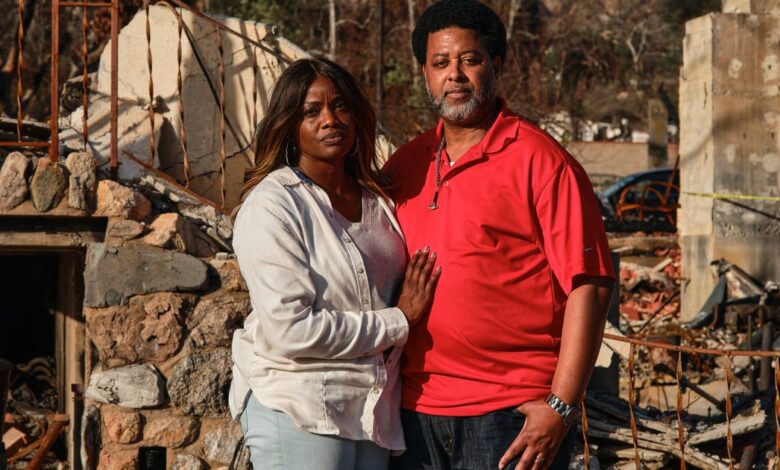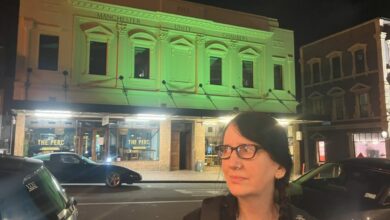Altadena Residents Grapple With Rebuilding After Eaton Fire

Marcus Betts and his family lived in Altadena for generations, so the 52-year-old was no stranger to the blazes that plague the Golden State. But as the Eaton fire broke out on the evening of Jan. 7, it was whipped up by staggeringly powerful Santa Ana winds.
A friend of Betts’ mother first texted them that the fire was just a few miles away.
“I went upstairs to my mom’s room and looked out her east-facing window, and I could see a red glow. And that’s when I knew that this is different,” said Betts, who works as an analyst in the baking industry.
That began a scramble to check on friends and elderly relatives, warning them they might need to evacuate, and helping some pack bags. By around 9:30 p.m., they still hadn’t gotten an evacuation order from the city. But Betts and his household — which includes his wife, his two teenage daughters, his brother and his mother, decided to pack up some of their belongings anyway. When the power went out, they officially made their exit.
After giving a family friend a ride to safety, Betts, along with some other friends and relatives who lived in the area, gathered at an uncle’s house near the Rose Bowl in Pasadena for refuge. He estimated that about 16 people and five dogs were there.
But it was a sleepless night for many of them. Around 3:30 a.m., Betts, two uncles and a cousin jumped into action. They drove back toward the flames, as hurricane-level winds pushed against them, and hosed down at least six homes.
“There was times that we were hosing down the houses, and the water literally was coming directly back at us, like, literally we were soaked from the strength of the winds. The water was coming straight back into our faces. But we persisted,” Betts said. “Once we felt we put as much water as we could without us then freezing as well, we decided to head out.”
Despite their best efforts, hours later, Betts discovered that all but one of the houses they hosed down had burned to the ground when he returned to the scene that morning. The house that remains standing belongs to Betts’ uncle. As he and other family members drove through the area to assess the damage, he snapped photos along the way of houses belonging to people he knew. He knew they’d want to see proof of the incinerated remains of their homes.
“Fortunately, we all made it out, and we all got what we could,” he said. “But other than that, everything is gone.”
Philip Cheung for JS
Roughly three months after the Eaton fire started, which burned 14,021 acres, destroyed over 9,400 structures and killed at least 18 people, many Altadena residents like the Betts family are still without a permanent home, starting over as the national news has largely slowed its coverage of the calamity.
Now, with scorched ruins across much of Altadena, Betts and others are voicing concerns about rebuilding. As the Betts family’s hectic evacuation night of helping friends and relatives shows, the unincorporated Los Angeles County community is a tight-knit one, with a history and appeal that would be hard to reproduce. Excluded from other neighborhoods for decades because of racist practices, Black families like Betts’ achieved home ownership in West Altadena — and often passed those homes down to their children. As Southern California property values skyrocketed, the area, nicknamed “Beautiful Altadena” and considered an “architectural mecca,” remained relatively affordable.
As wealthy developers set their sights on the area and as the chaos of President Donald Trump’s second administration brings new economic uncertainty, staying true to the heart of Altadena and its history presents a daunting challenge, particularly for families who are just starting to navigate insurance claims, debris removal and restarting their lives from scratch.
“I don’t think there’s anybody who was in Altadena that night that could see that it was going to be this,” Betts said. “I do find it hard to receive, hard to accept that we lost so many houses, so many structures, and we lost life.”
Though wildfires have always been part of the ecosystem in Southern California, an unusually dry fall and winter primed the region to be a tinderbox. Then came the windstorm, knocking down trees and power lines.
Sparks ignited into massive fires, notably the Palisades fire that scorched 23,707 acres in the coastal and canyon areas between Santa Monica and Malibu, coinciding with the Eaton fire on the opposite side of LA County.
In Altadena, where the population was almost 42,000, approximately 18% were Black residents according to the 2024 census data. The Hispanic population was around 27%, while white residents made up about 42%, with 5% Asian and 7% of mixed ethnicity. Surprisingly, over 80% of the Black residents in the region were homeowners, almost double the national rate of Black homeownership, which was attributed in part to redlining policies.
Historically, restrictions in Altadena dictated that white residents lived on the east side of North Lake Avenue, while nonwhite residents resided on the western side until the Fair Housing Act of 1968 lifted those restrictions. However, many Black residents remained in their homes for generations, creating a close-knit community that was disrupted by the Eaton fire.
Unfortunately, during the Eaton fire, 17 out of the 18 deaths occurred in western Altadena, where residents did not receive evacuation orders until eight hours after the eastern side did. This delay in evacuation orders highlighted disparities in emergency response and prompted calls for investigations into the evacuation procedures and notification systems.
Adam Frankel, who lost his rental home in the fire, expressed concerns over the unequal treatment of wealthier white neighborhoods compared to historically Black and Hispanic working-class areas. He emphasized that systemic racism permeates all aspects of society, including disaster relief efforts, and called for more equitable support and resources for communities of color during such crises. Following an Altadena Town Council meeting in January that left many residents’ questions unanswered, Frankel and Martinez sent an email demanding relief for the unique needs of the community’s renters, low-income residents, and marginalized groups to Chair Victoria Knapp, Vice Chair Nic Arnzen, and LA County Supervisor Kathryn Barger.
The email expressed disappointment that the council did not acknowledge Altadena’s rich and unique history as a historically Black, ethnically diverse, majority working and middle-class community. It also highlighted the disproportionately severe harms caused by the fires on low-income residents and BIPOC communities.
Despite their efforts, the council never responded to Frankel and Martinez. Knapp, Arnzen, and Barger also did not respond to JS’s request for comment.
Frankel expressed his disillusionment with government officials, stating that their failure to address the crisis shattered his belief that local and state government is there to help the public in emergencies.
Months later, Frankel continued to be impacted by the fallout of the fires both personally and professionally, as he works on hazardous waste issues as an environmental justice attorney.
The night the fire broke out, Frankel, Martinez, and their two dogs had checked into a hotel in Hollywood due to dangerous winds. They had only packed for a two-night stay, assuming they would soon return to their rented home.
The next day, they found their neighborhood destroyed, with their home and belongings lost. The chaotic scene and lack of coordinated response added to their distress.
Despite the devastation, Frankel’s deepest sadness was for longtime residents who had deep ties to the community and the land.
As national news coverage of the fires waned, the residents of Altadena faced the daunting challenge of rebuilding and moving forward. Like many Altadena residents, Frankel and Martinez, along with the Betts family, have started fundraisers on GoFundMe to help cover essential items and find a new place to live after the fire.
Betts expressed frustration with the itemized list required by insurance companies, calling for a simpler process to receive compensation.
Recovery from natural disasters presents daily challenges, according to Frankel, who highlighted the struggles faced by victims in tasks as simple as getting mail or seeking medical care.
While staying in an Airbnb in Los Angeles, Frankel and Martinez are hesitant to move back to Altadena, wanting to save space for residents with deeper community ties.
Meanwhile, the Betts family is living in a rental property in Lakeview Terrace, awaiting progress in rebuilding efforts.
Despite filing a “right of entry” form for debris cleanup, Betts has yet to see any action, with over 13,500 properties eligible for clearing.
The rebuilding process is further complicated by Trump administration policies and economic uncertainty, potentially raising construction costs.
Developers purchasing burned-out lots in Altadena have raised concerns about gentrification and preserving the community’s unique charm. Residents have protested against the selling of properties, declaring “Altadena is not for sale.”
Preserving Altadena’s Legacy After the Eaton Canyon Fire

There is at least one alternative, though: selling to a nonprofit known as Greenline Housing Foundation, LAist reported. Greenline seeks to combat racial housing discrimination. It has already bought at least one property for $520,000 earlier in March, promising the home that is rebuilt there will be sold below market value to a first-time buyer.
Even as he hopes the rebuilding process is simplified, Betts noted that it’s just as necessary for officials to find long-term solutions to climate change.
“It just needs to be more done, and it needs to be long-term resolutions and solutions to avoid from happening in the future,” Betts said. He then warned: “If you keep just closing your eye and looking the other way, is only going to get worse and worse, and it’s going to destroy your home eventually.”
Betts, the son of a carpenter, said he’s willing to do whatever it takes to restore Altadena to its original beauty.
“I haven’t swung a hammer for real in a long time since, probably, I was in my 20s or something with my dad, but I’ll do whatever I can to help the community come back,” Betts said.
“I really want to see Altadena maintain its legacy, and maintain its uniqueness in its design,” Betts continued. “My fear is that there’s going to be these large corporations, these large developers that buy blocks at a time and change the landscape of Altadena to make it look like it’s in all other cities. And Altadena is totally different from any other city I’ve ever lived in or have visited, and I would hate to see that end up being Altadena’s future, because that’s most important to me, is the legacy and the character.”
text in a more concise manner:
“Please provide a brief summary of your qualifications.”
“Summarize your qualifications briefly.”





